Recent Water Damage Posts
Fixing Your Leaky Toilet
8/16/2022 (Permalink)
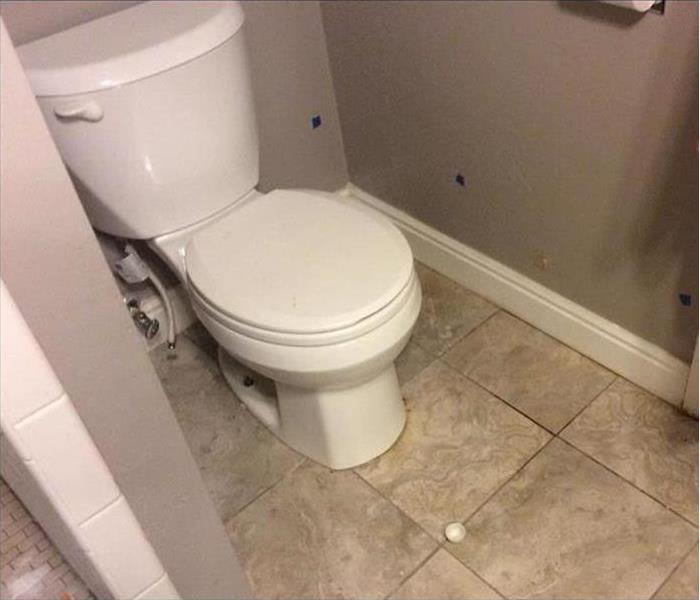 A leaking toilet in Ogden, UT.
A leaking toilet in Ogden, UT.
Suddenly discovering a puddle of water in the bathroom can be concerning. In most cases, the cause of a bathroom leak is the toilet. While a leaking toilet is a problem you’ll want to address as quickly as possible, it isn’t as daunting as it might seem. Here are steps you can take to stop the leak and minimize the impact of water damage to your home.
4 Steps to Stop a Toilet Leak
1. Find the Leak
The first visible indication that your toilet has a leak is the presence of water on your bathroom floor. However, sometimes, you won’t see any water at all. That’s because leaking water can get trapped between your flooring and underlayment. If you suspect a leak, probe the floor for spots that feel soft or spongy. If the toilet is on an upper floor, water can leak down the flange and stain the ceiling below. You can’t miss the unmistakable odor of sewer gas when a toilet isn’t seated properly.
2. Tighten the Bolts
Once you’ve determined the toilet is the culprit, inspect its fit. Is it stable, or does it rock? If the anchor bolts on either side are loose, tighten them down. Alternate when tightening to ensure you don’t overdo it. Too tight, and you could break the flange.
3. Replace the Wax Ring
If the leak persists after tightening the bolts, you’ll have to replace the wax ring that sits between the toilet and the flange. Over time, this ring can dry out and break the seal, resulting in a leaking toilet. You’ll need to uninstall the unit, remove the old ring and install a replacement.
4. Beware of Hidden Damage
Hopefully, you’ve caught the leak early enough. If the toilet leak has exposed your subfloor and structural supports to water, however, there may be larger issues you need to consider. If there’s any question whether the leak has caused rot or damage, contact a restoration specialist in Ogden, Utah, who can assess the situation and suggest the proper repairs.
If you find you have a leaking toilet, address the issue as quickly as possible. If necessary, call in a professional for expert help.
3 Steps To Take To Fix a Flooded Basement
7/18/2022 (Permalink)
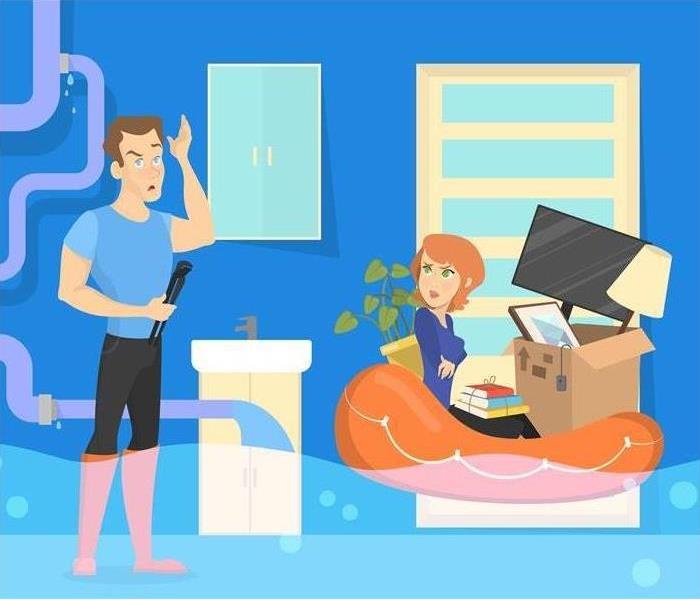 Fix your flooded basement and avoid further damage.
Fix your flooded basement and avoid further damage.
Because of its location, your basement is likely to be the first part of your home to fill with water during a severe flood. A basement flood can cause damage to your foundation, electrical system and any property located in the basement. It can also be an electrocution hazard. These are three steps you can take to fix your flooded basement.
Steps to Fix Your Flooded Basement
- Turn Off the Power
Standing water can become electrified if it comes in contact with a power source, so before you do anything else you should make sure the power to your home is shut off. If the water in your basement is shallow, you can use dry lumber, a step stool or a ladder to get above the water level and shut off the power at your service panel. Wear rubber boots and gloves to protect yourself. If the water is above the level of any electrical outlets or you can't get to your service panel, call the power company in Ogden, UT, and ask them to disconnect your house from the power grid.
- Remove the Water
You can use a wet-dry vac or a mop and bucket to remove the water from a minor basement flood. However, you will need to contact the fire department or rent a heavy-duty gas-engine pump to drain a severely flooded basement. Alternatively, you can contact a water remediation company to assist you.
- File an Insurance Claim
If you have flood insurance, your insurance coverage may pay for the cost to drain and dry out your basement and replace any damaged property. Contact your insurance agent or claims department as soon as possible to get your claim started.
A basement flood in your home can be a major hassle and a safety concern. Taking the proper steps to fix your flooded basement can reduce your potential property damages and protect your family.
Water Mitigation Procedures for a Leaking Water Heater
6/17/2022 (Permalink)
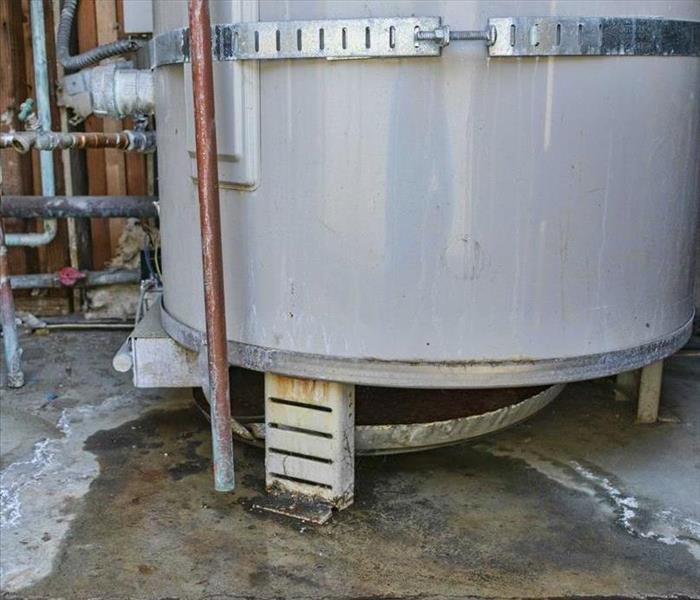 Learn More about the Water Mitigation Procedures with Our Professionals.
Learn More about the Water Mitigation Procedures with Our Professionals.
Homeowners often take their water heaters for granted until they stop working correctly. You may never think about how hard your appliance works each day to provide you with the essential hot water for taking showers, cleaning dishes, and washing clothes.
Unfortunately, sometimes there is nothing you can do to prevent a leaking water heater, but there are steps for mitigating the damage if it happens.
Steps To Take After a Failed Water Heater
1. Turn Off All Utilities
When you're experiencing a leak, it's best to shut off your water supply until you find the source of the leak and fix it. You can shut off your water at either your home's main valve or the valve that leads directly to the water heater. You should see two valves (i.e., for hot and cold water) beside the water heater.
If you have a gas-powered water heater, shut off your home's gas supply. Then, turn off the power to your home or the breaker for the water heater. Now, you can safely look for the leak and repair it.
2. Drain the Water Heater
If you have more than a tiny leak, it may be best to drain the water heater. Draining it will ensure that an influx of water doesn't occur, which could cause more damage to your home and contents. Draining the water heater is a simple procedure; connect a hose to the drain valve. This valve is located at the bottom of the appliance. The hose should allow the water to travel outdoors. Gravity will do the work of draining it once you loosen the drain valve.
3. Look for the Leak
There are several places from which your water heater may be leaking. Most of the time, water from a leaking water heater originates from the bottom of the appliance. Therefore, you may want to inspect that part first.
4. Remove All the Standing Water
Hopefully, you have a drain pan there to catch a leak and avoid water damage. However, if you discover standing water, it's essential to extract it as soon as possible. The easiest way to do this is to use a wet/dry vacuum. If the water has been sitting for a while, you may need to call water damage restoration professionals to inspect and repair the damage.
5. Remove the Excess Moisture
Next, it's time to remove the excess humidity from the air. Using a humidifier tends to work the best for this. You can also use heaters, fans and fresh air. If you see mold, avoid anything that will cause air to blow, as it can spread mold spores.
6. Inspect for Water Damage
Homes can sustain damage quickly with excess moisture, especially standing water. It's critical to inspect the entire area before and after cleaning and restoration.
If you discover that you have a leaking water heater in Ogden, UT, you will need to find the source and repair it as soon as possible. You'll also need to clean up the water immediately after stopping the leak. You can often prevent a broken water heater by regularly maintaining it.
How Does Water Affect Building Materials?
4/9/2022 (Permalink)
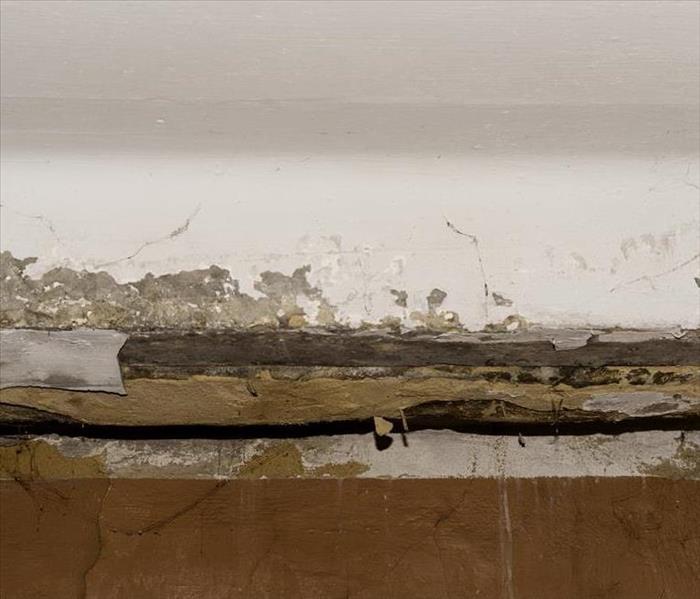 Prevent Water Damage by Following these Tips.
Prevent Water Damage by Following these Tips.
Discovering water damage in your Ogden, UT, home can be overwhelming. Sometimes it can even be more stressful than the disaster that initially led to the loss. Excess moisture can cause various types of deterioration; the structural makeup of the affected material is a huge factor in determining the extent of the damage. Some materials are much more absorbent than others.
Unfortunately, many materials used to build homes are quite porous. These materials include wood, drywall and insulation. Considerable damage can result from the intrusion of excess water from a flood, burst pipe, leaking roof or another catastrophe. What if this happens in your home?
6 Steps for Dealing With Water-Damaged Materials
Unfortunately, every second counts when it comes to water's effect on many materials. This means that it will probably be impossible to prevent some loss. Therefore, the focus will be on mitigating the deterioration. There are some basic steps to take to lessen the risk of significant damage after a water disaster.
1. Shut Off the Electricity
First, remember to shut off the electricity to the affected area. Even very shallow standing water can carry an electric current that can harm you on contact.
2. Extract Standing Water
It's essential to extract all excess water as quickly as possible. Typically, the best way to do this is to use a wet/dry vacuum. Unlike a regular vacuum or mop, a wet/dry vacuum also lets you safely and efficiently remove wet debris.
3. Remove Flooring Materials
Your flooring will probably not be salvageable if you've had standing water. Water-soaked wood floors can swell and buckle if they are left to sit. Carpeting and padding typically won't be salvageable if saturated because they are usually impossible to dry completely quickly enough to prevent damage. You will also need to inspect the subfloor, dry it, or replace it before reinstalling flooring.
4. Tear Out Wet Drywall and Insulation
Soaked drywall and insulation should be torn out and replaced. Drywall is very porous and can soak up water like a sponge. It can be extremely tough to dry entirely in time to prevent permanent water damage and mold growth. Wood cabinets can also swell with water and must be replaced.
5. Begin Drying the Affected Area and Contents
First, you will need to remove anything that isn't salvageable to eliminate as much excess moisture as possible. Mold can begin growing within 24 hours, so it's essential to use multiple drying techniques. There are several ways to dry the area and contents: fans, heaters, dehumidifiers. You can also open doors and windows to allow fresh air to flow through, as long as the humidity outdoors is lower than indoors.
6. Call the Professionals
You will need to hire flood damage restoration professionals to thoroughly inspect the area and clean and sanitize it. After the plumbing repair, the remediation experts will ensure that everything is completely dry and free of mold growth. Ultimately, they will return the site to its pre-flood condition and perform a final inspection.
Floodwaters from a disaster, such as a supply line leak, can begin showing water damage immediately. Knowing the steps to take after a flood is vital to your family's safety and your home's security.
How To Avoid Frozen Pipes
11/15/2021 (Permalink)
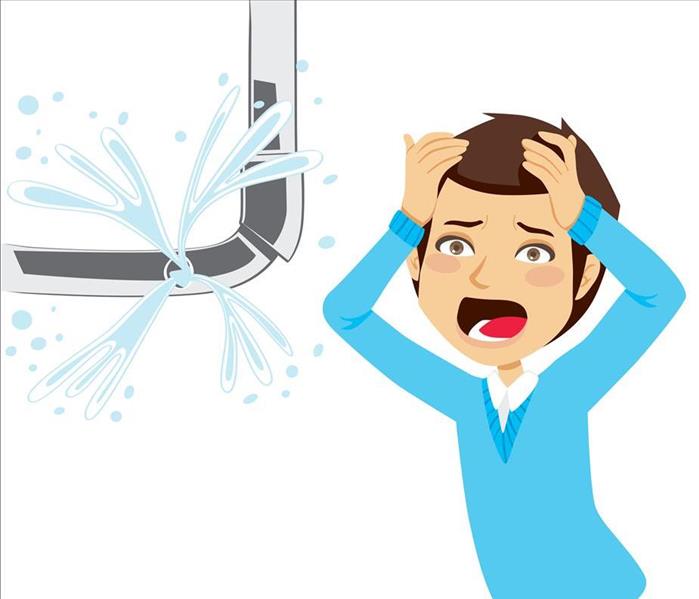 Water damage caused by burst pipes it can be expensive and catastrophic for your Ogden, UT home.
Water damage caused by burst pipes it can be expensive and catastrophic for your Ogden, UT home.
Frozen pipes can cause a lot of damage to your home if they burst. In addition to having to repair or replace the pipe itself, you must also contend with the damage to the structure around it caused by the surge of water it releases. To protect your home in Ogden, UT, from extensive water damage caused by a frozen pipe, take the following precautions.
6 Tips to Prevent Frozen Pipes
Proper Insulation
You probably pay close attention to general insulation for your home, but what about insulating the pipes themselves? Even if you have a layer of protection from the extreme winter cold, it may not be enough to protect your home from a pipe freeze. Add extra insulation to pipes located in specific areas:
- Attached to an outside faucet
- Along an external wall
- In the crawl space or attic
You can purchase heat tape or cables directly to vulnerable pipes. Most hardware stores have these items in stock. Be sure to follow the manufacturer's instructions carefully when applying them for optimal results.
Protection From Outside Air
No matter how well insulated your home is, pipes can still freeze if you have spaces where cold air can leak in. Check your windows and doorways for drafts during regular inspections, particularly right before the first freeze. Any appliances that vent to the outdoors are also common sites of leaks. Use caulk to seal any gaps you find.
Steady Stream
Sometimes a simple solution is the best one. A slow drip from your faucets can prevent frozen pipes. The steady stream of water keeps the pipes warm enough to stay intact. While you may worry that this wastes water and drives up your utility bill, think instead of how much money you save by not suffering the immense water loss caused by a broken pipe.
Warm Home
Keeping your home warm can also keep your pipes warm. Some homeowners lower the thermostat overnight when the family is bundled up in bed, but this can lead to water damage from a pipe burst. Set your thermostat at a consistent temperature throughout the day and night to keep pipes warm at all times.
Vacation Preparation
If you are not going to be at home for several days or weeks, you must protect your pipes so that you don't come home to a big mess. Set the thermostat no lower than 55 degrees so that the house stays warm. Turn off the water main. That way, if a pipe does break, there is nothing in it to flood your home. Ask a neighbor or a friend to check on your house occasionally while you're gone to make sure everything is as it should be.
Quick Response
Even if you take all of these precautions, a pipe may still freeze and release water. A fast response is key to minimizing the damage it leaves behind. Call your plumber to repair the pipe and water damage mitigation specialists to provide the cleanup.
Taking care of your pipes is important, particularly when it's cold outside. Know how to prevent frozen pipes and what to do if a break does occur.
How To Mitigate Sewer Damage to Two or More Floors
10/6/2021 (Permalink)
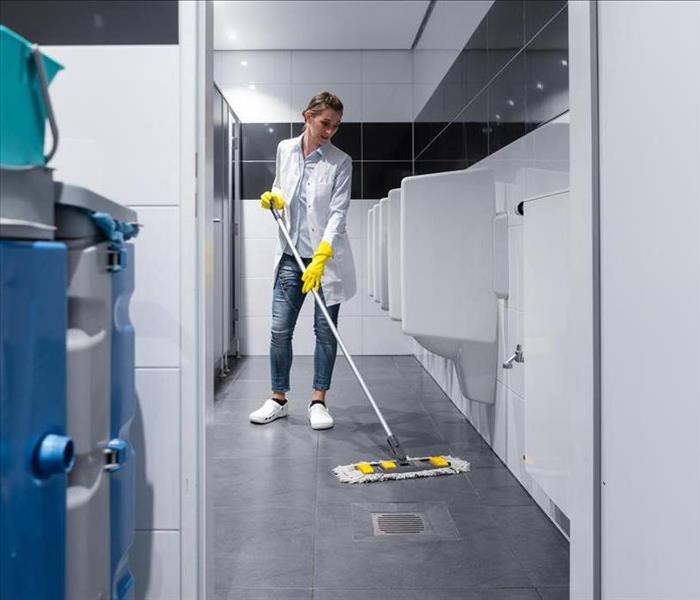 An overflowed toilet means sewer damage in your Ogden, UT commercial building.
An overflowed toilet means sewer damage in your Ogden, UT commercial building.
Restrooms in your commercial building in Ogden, UT, are designed for easy cleaning. Every surface is easy to wipe down, and toilets are often self-flushing to prevent backup. When overflow does occur, however, it can make a big mess that doesn't necessarily stay in the room itself. Any space adjacent to or under the restroom may have sewer damage after a toilet malfunction. Water damage mitigation specialists often must address the issues in the restroom as well as the materials and floor beneath it. The typically simple remediation process gains a few steps when damage to multiple floors is involved.
1. Assessment of Sewer Damage
The first thing that technicians do when they arrive on site is to assess the extent of the damage. Because much of the overflow from the flooded toilet is likely to seep in between the tiles on the floor, they may have to remove portions of the material to see how far the problem goes. At the end of the assessment, they should be able to provide a report that provides useful information about the rest of the process:
- Cause of the problem
- Repairs the sewage company needs to provide to prevent further damage
- Areas affected
- Level of contamination and damage
- Tasks involved in mitigation
- Estimated cost of repairs
2. Extraction of Water
Once the members of the remediation team know what needs to be done, the next step is extracting any excess water or sewage from the affected area. Industrial pumps and various other drying methods may be used to remove water, thus stopping the damage in its tracks.
3. Removal of Materials
Having extensive sewer damage that affects the floor beneath the restroom means that technicians will probably need to remove a lot of materials. Not only must they rip out ruined pieces of flooring under the toilet itself but they also must tear out drywall, insulation, and ceiling tiles from all surrounding areas that have been contaminated by the flooding.
4. Disinfection of Surfaces
Since damage from a flooded toilet most likely has a Category 3 contamination level, all remaining surfaces must be disinfected. This part of the process removes any harmful microbes or bacteria, protecting your building and the people in it.
5. Drying of Area
Unmitigated water damage can lead to secondary issues such as mold growth. Therefore, ensuring that the entire area is completely dry before the structure is rebuilt is essential for preventing additional problems. All remaining materials must be free of damage and excess moisture.
6. Restoration of Building
The final step in the mitigation process is restoration. The team doesn't just leave your building gutted and clean. They replace the ceiling, walls, and flooring materials, matching them to the existing structure so that no one can tell there was damage.
Sewer damage from an overflowing toilet may seem like a small problem on the surface, but it can have far-reaching effects, particularly if the water seeps into the floor below it. A trustworthy mitigation team can find and fix all the damage caused by the overflow so that your building's structure remains secure and strong.
Preparing for an Adjuster Visit After Water Damage
9/23/2021 (Permalink)
 Schedule as soon as possible a visit with an adjuster after water damage in your Ogden, UT home.
Schedule as soon as possible a visit with an adjuster after water damage in your Ogden, UT home.
Water damage can stem from a variety of circumstances, from pipe breaks to storm surges. While your home insurance policy will vary depending on the cause of the damage, in most situations, an insurance claim will require a visit from a home adjuster. The adjuster will want to identify and verify any damage to make a proper recommendation about claim approval. During their visit to your home, the insurance adjuster will be looking for several things, including:
- Evidence of structural damage
- Cause of the damage
- Receipts for claimed losses
- Estimates for repairs
- Mitigation attempts
Looking To Ensure Damage Was Mitigated
While you might feel overwhelmed after a water disaster, you need to remember that you still have responsibilities as the homeowner. An insurance company expects all clients to mitigate further loss after a disaster, meaning if water damage occurs because of a hole in the roof or a pipe break, you are likely expected to either cover the hole or shut off the water supply to prevent more damage to the property. Be aware that failure to mitigate further loss can result in the denial of your claim.
It is also worth mentioning that your insurer likely doesn’t expect you to resolve the issue completely. They mainly want to see that you put forth an effort to minimize the extent of the damage. Additionally, you do not have to mitigate the problem alone; it is strongly advised that you seek assistance from a professional mitigation company in Ogden, UT.
The home adjuster will take time to assess mitigation efforts because if they find evidence that you didn’t do enough, it saves the insurance company money. Remember, the insurer is not your friend; they do not want to give you money, and they especially do not want to give you more than they have to.
Making the Adjuster’s Visit Easy
Do yourself a favor and make the adjuster’s visit as straightforward as possible. To make their visit easy, you should put together a loss inventory. This document will include an itemized list of all damaged or destroyed items. If possible, include pictures of all the items along with copies of receipts.
Additionally, you should compile a list of any structural damage to your home. The list should identify the specific location and any damage; for example, the left interior wall of the basement has a crack and is showing signs of moisture penetration.
Finally, you will want to have copies of repair bids. The adjuster will need to see estimates of the damage done to the property. A remediation company can help you gather any necessary information, including a loss inventory.
It is important to remember that while an insurance company might have preferred contractors, you do not need to work with them for a claim to be approved. It is important to hire the professional you feel most comfortable with.
A home adjuster visit is a requirement of the claims process. While every insurance company is different and will have different expectations for their clients, the above information is pretty standard. For more information, you might want to contact your insurance provider.
How To Deal With Wayward Sprinklers and the Damage They Cause
8/17/2021 (Permalink)
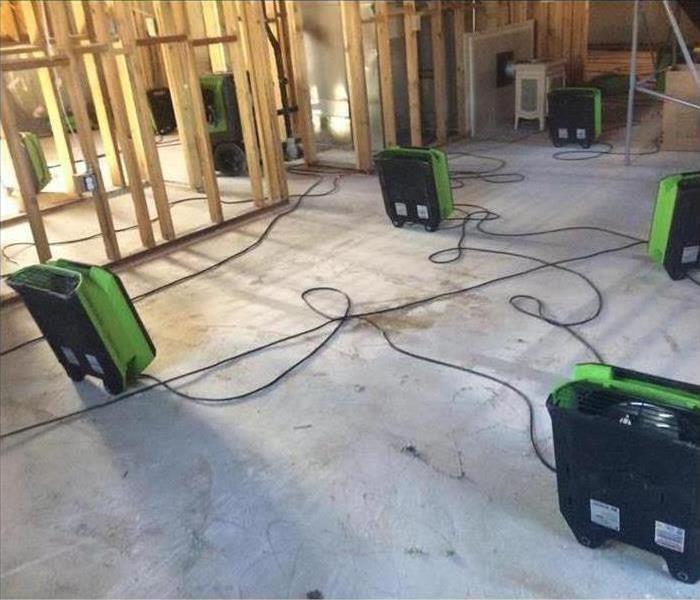 Air movers on water damage in a South Ogden, UT home
Air movers on water damage in a South Ogden, UT home
Studies indicate the fire sprinklers do far more good than harm, and that they actually end up saving both business owners and homeowners money when they deploy. When sprinklers deploy during a fire, they cut the typical cost of fire damage by half. Then there are the life-saving benefits of sprinklers. Some statistics that may surprise you are as follows:
- Sprinklers reduce the average property loss by as much as two-thirds compared to a fire not controlled by sprinklers, even if they do cause a bit of flooding.
- There are no accounts of a fire killing more than two people in a public building fire in which a working system was present.
- Combined with smoke alarms, sprinklers cut the risk of a person dying in a home fire by 82 percent.
The stats clearly show that sprinklers are a worthwhile and necessary investment. That said, it is not unheard of for fire sprinklers to deploy without cause. When this happens, they can cause significant water damage, and you may want to know what your options are when they do.
What To Do When Sprinklers Go Off Without Cause
When sprinklers go off without cause, they can cause significant flooding and costly damage. You can minimize the cost of damage by turning off the water supply line immediately. Once the line is off, take down the wayward sprinkler and its components and bring it to the sprinkler's manufacturer or your Ogden, UT, fire department. Someone should be able to help you determine the cause.
If the cause of the malfunction has to do with faulty equipment rather than lack of maintenance, damage caused to your building, as well as replacement of the system, should be covered by your insurance company. As for cleaning up the flooding and subsequent damage caused by the faulty sprinkler, contact your water remediation team right away before the damage becomes much greater than a bit of wet carpeting and equipment.
How To Keep Your Construction Site Free of Water Damage
8/11/2021 (Permalink)
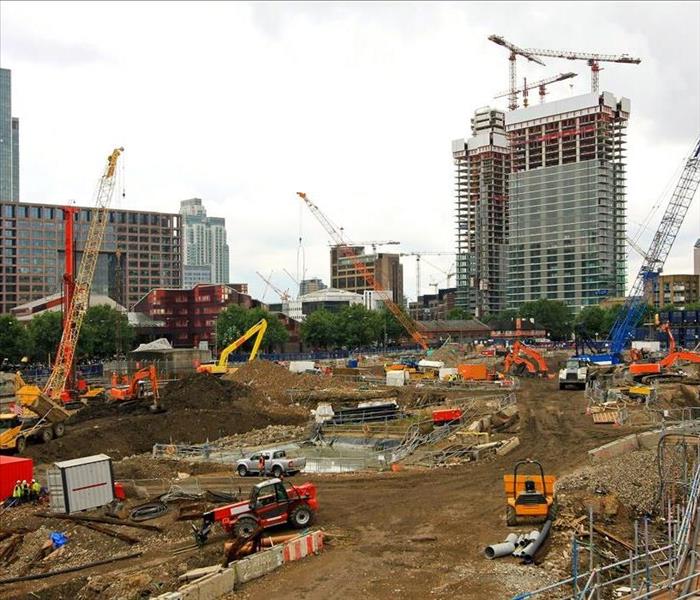 Water damage can be prevented at your building construction site in Ogden, UT.
Water damage can be prevented at your building construction site in Ogden, UT.
There are many things that can delay the construction process of your new commercial building in Ogden, UT. Malfunctioning equipment or delays in paperwork approval are likely to disrupt the timeline of the overall project, and that is not something you can always avoid. Other issues such as water damage, however, can usually be prevented through timely water pipe repair, proper drainage, or effective tarping. Here are some ways to ensure that your project isn't unnecessarily derailed
Building Envelope Protection
As the building is being erected, there are several ways to prevent water from getting inside, even if there are storms or flooding in the area. Measures should be taken when the crew is not present to board up or secure tarps over all the open areas:
- Doorways
- Windows
- Roof openings
The crew members should also identify other vulnerable spots in the structure as they finish up each shift so that they can cover those areas as well. Consistent protection keeps the crew from having to redo parts of the structure by preventing water damage in the first place.
Groundwater Awareness
Rain is not the only way that water issues can occur. Unexpected seepage from groundwater can lead to a flooded building in no time. Avoiding this problem is one of the benefits of a thorough land survey before construction even begins. Having a detailed map of the area where the site is located helps the crew avoid unpleasant surprises.
Good Drainage Practices
No matter how careful the construction crew is, accidents sometimes happen. For example, if a pipe breaks during testing, there will be some type of water loss, even if the source is shut off quickly. Having a good drainage system that diverts the excess water away from the structure already in place can minimize the damage it causes. The project manager can then focus on finding someone to complete fast water pipe repair and complete any minor mitigation that is needed.
Damage Mitigation
A broken pipe can lead to significant water damage, particularly if it happens overnight when no one is present to respond quickly to the problem. If this occurs, the affected parts of the structure will likely need water damage mitigation services before further construction can continue. The cleanup experts can assess the extent of the damage, tear out ruined materials and make sure the building is dry so that further damage doesn't happen. Then work on the project can resume with the confidence that no structural damage remains.
The construction of a new commercial building from the ground up is an exciting prospect. With the freedom of design and increase in control, it brings, however, it also comes with certain risks. Quick water pipe repair alone may not be enough to prevent water damage to the vulnerable structure while it is under construction. Having solid flood prevention measures in place can minimize damage, and putting trusted mitigation experts on speed dial can get the project back on track in a timely manner. Your contractor should be able to walk you through the measures the crew has in place to protect your building throughout the process.
The Process of Becoming a Preferred Vendor
6/28/2021 (Permalink)
 SERVPRO is always there to provide the best service possible.
SERVPRO is always there to provide the best service possible.
Many homeowners in Ogden, Utah, rely on an insurance agent to recommend a preferred vendor when they need the services of water damage mitigation experts. To receive referrals from the corporate office, SERVPRO franchises must follow 21 different guidelines. This standard of excellence assures both insurance providers and their clients that they are getting the best professional service possible.
Claims Information Center
When providers look for preferred vendors, one of the factors they consider is usually the accuracy of job progress reporting. The SERVPRO Claims Information Center keeps track of every aspect of each job:
- Assessment of original damage.
- Ongoing updates of process.
- Estimated cost.
- Additional damage found during mitigation.
The CIC is instrumental in helping providers streamline the claims process so that they can better serve their clients. It helps maintain transparent communication between the technicians involved in the restoration and the company footing the bill. It also is an easy way to keep homeowners up to date on the progress being made.
Franchise Responsibilities
Carrying the name SERVPRO your franchise isn't enough to secure referrals from the corporate office. Each franchise must meet certain standards of excellence to qualify for the vendor program. For example, all technicians must undergo a background check and complete rigorous training by the IICRC to ensure their work is up to par. The franchise owner must also be insured to protect customers. Only franchises that have passed all 21 points of the validation guidelines are eligible to receive referrals for jobs that come through the call center.
Every insurance agent knows the importance of having reliable contacts in the damage mitigation and restoration industry. Each SERVPRO franchise should aspire to the standards set by the company to become a preferred vendor for insurance providers and their clients. Maintaining that level of excellence is a lot of work, but it pays off in the trust that it inspires in your reputation.
Preventing Water Damage
3/29/2021 (Permalink)
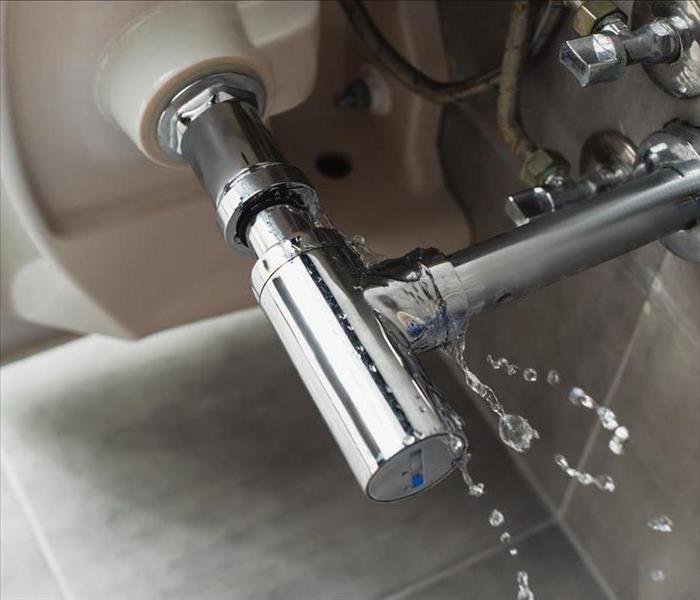 Schedule a biannual inspection to prevent water damage.
Schedule a biannual inspection to prevent water damage.
Most homeowners think of water in home as that coming from taps or faucets. The idea of floods or broken sewer and water lines are typically the last things any homeowner wants to think about because it can lead to stress. However, as any water mitigation specialist in Ogden, UT, can attest, there are at least five ways to prevent residential water damage.
5 Ways to Prevent Water Damage
1. Maintain Appliances
While the break of a supply line can lead to a pipe cleanup, many home water issues stem from failing appliances, like washers or water heaters. All equipment in your house needs to follow a strict maintenance schedule. By creating and following such a schedule, you can resolve most problems before they cause significant and costly damage.
2. Clean Downspouts and Gutters
One of the leading causes of water in home is a clogged or backed-up downspout or gutter. If you do not clean the gutters and downspouts, the rainwater has no place to go except back up under the sheathing of your roof, leading to leaks and rot.
3. Install Water Detection and Flood Prevention Devices
It can be challenging to find a broken pipe because most sit behind walls or within ceilings. By installing water detection and flood prevention devices, you can receive alerts to excess water in the home, allowing you to address the matter quickly.
4. Maintain Trees and Plants
Roots can cause a lot of damage to sewer lines. Ensuring that all trees, shrubs, and plants are well-groomed and maintained, you can save yourself from the expense of sewer collapse or failure.
5. Schedule Annual and Biannual Inspections
The key to water damage prevention is annual or biannual inspections of all vital systems, including your roof. Routine assessments mean you can catch problems before they become significant expenses or lead to extensive damages.
Finding water in home is a nightmare scenario for most homeowners. Do yourself a favor and heed the above advice to reduce your water damage risks.
Common Consequences of Water Damage
11/25/2020 (Permalink)
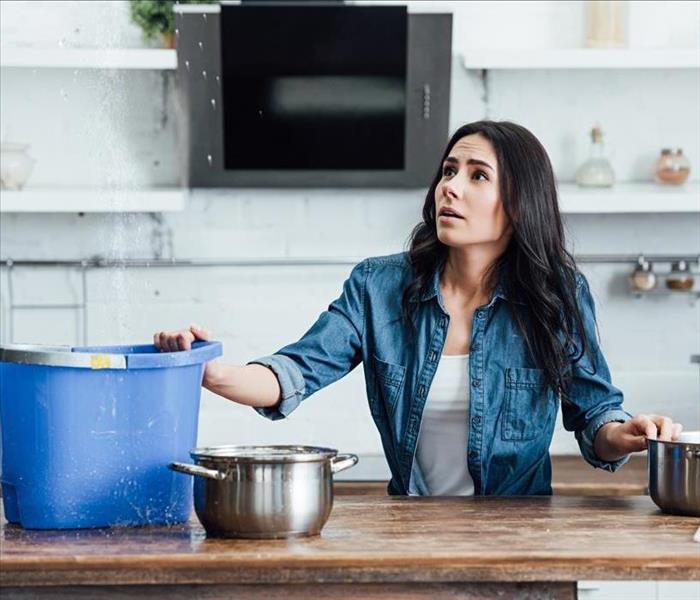 Water damage on kitchen ceiling.
Water damage on kitchen ceiling.
When people think of water, it is often in regards to sandy beaches or long, relaxing soaks in the tub. Hardly any homeowner thinks about water damage unless they actually experience it first-hand.
However, when a homeowner experiences such damage or threat of it, they likely fear the worst. Thankfully, water problems vary in the degree of challenges, and while there are significant and costly issues that may arise, the three most likely are as follow:
- Wallboard and ceiling tiles
- Flooring
- Cabinets and furniture
3 Common Consequences of Water Damage
1. Wallboard and Ceiling Tiles
Many people realize they need a plumbing repair because they find staining on wallboards or ceilings tiles. The staining is an indicator of where the problem is, but it doesn't always mean there is a significant problem. Sometimes, a large stain can stem from a small leak, meaning repairs are minor.
2. Flooring
Pipes also run under your flooring, which can lead to significant problems in the event of a pipe break. However, even water damage stemming from a sink leak can lead to issues with your flooring. While water may cause irreversible damage to laminate and other flooring types, hardwoods can often be sanded down and refinished. However, you will need to inspect the subfloor, and you might want to hire a mitigation service in Ogden, UT, for such an inspection.
3. Cabinets and Furniture
A supply line break can also damage cabinets and furniture, depending on its location. The quality of the furniture and cabinetry will also play a role in the salvageability of the materials. If made from hardy woods and materials, the pieces can likely be restored, but if the furniture or cabinets use particleboard and MDF, the damage is likely permanent.
As a homeowner, it is vital to familiarize yourself with common water damage issues. Knowing about the possible problems can help you in your preparation and home management.
4 Major Ways Water Enters Your Basement
11/10/2020 (Permalink)
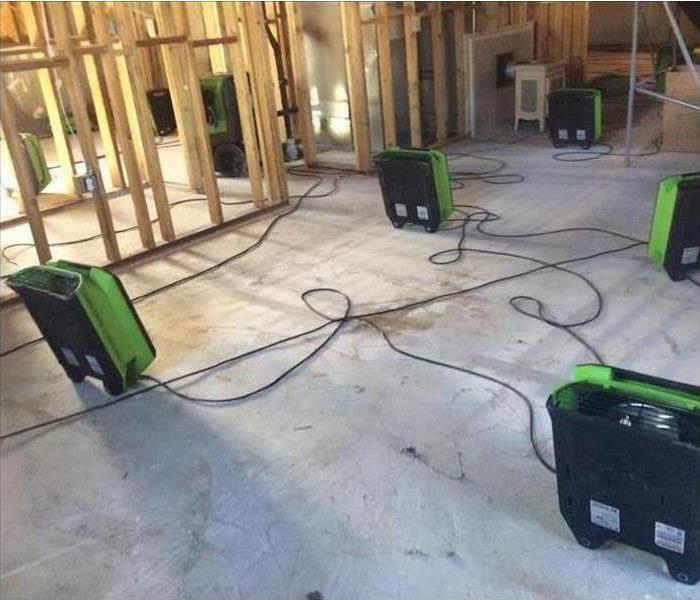 Air movers on water damage in a Ogden, UT home
Air movers on water damage in a Ogden, UT home
Nothing is more frustrating than dealing with a basement flood, especially when you can’t determine the cause. If your basement in Ogden, UT, has problems with water buildup during the rainy season, you may need to check for a few of these common problems.
4 Common Basement Problems That Can Lead To Water Damage
- Homes Built on Saturated Ground
When the ground is naturally moist, it can cause water to drain off into the lowest part of your property or the basement. If your home isn’t built on a floodplain, you can also check the soil moisture levels with the following tools:
- Soil moisture probe
- Tensiometer
- ET gauge
As a solution, you may want to direct water from the high points of your land to a drainage ditch by laying down tile lines.
- Improperly Sealed Walls and Floors
Cracks in the floors or walls can easily cause a basement flood, even if there isn’t a lot of rain. In some cases, the basement tiles of the house may not have been properly sealed or damage may have occurred to the concrete. Once you determine the source, you can patch up the cracks with epoxy sealers or cement.
- Damaged City Sewage or Drainage Systems
When a section of the city drainage system breaks or becomes plugged near your home, the water may come back up the pipes and cause a basement to become flooded. If this is the case, you may need to call a local authority to help resolve the issues.
- Blocked Gutters and Eavestroughs
When an eavestrough becomes blocked or clogged with debris, rain may overflow to the sides of your home and seep down into the soil next to your basement. Over time, the water buildup may create weaknesses in the foundation and cause cracks to occur. To fix this problem, you may need to install a screen mesh over the gutters or routinely clean the eavestrough system.
If you experience a devastating basement flood near Ogden, UT, make sure you call a professional cleanup crew. They can help you recover from water damage and help you resolve any major issues.
How To Troubleshoot 5 Common Water Heater Noises
9/22/2020 (Permalink)
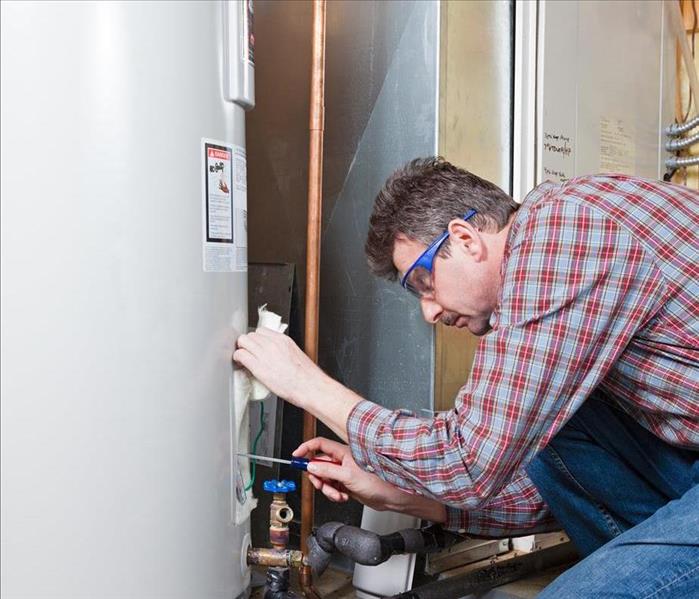 Regular maintenance is key to extending the life of your water heater.
Regular maintenance is key to extending the life of your water heater.
In a perfect world, your water heater would operate so silently and efficiently that you never have to think about it. In Ogden, UT, however, water heaters make noise. Here are five of the most common types of “concert” that they can perform and how to put an end to the performance.
5 Common Water Heater Noises
1. Screaming or Singing
When your unit makes a loud, screechy noise, it often means that there’s a valve that’s not opened completely. Check not only the water heater’s valves, but also your water lines and sinks.
2. Humming
This type of noise typically indicates that your electric water heater’s heating element needs to be tightened. The hum is produced by the flow of water surrounding the element creating a vibration.
3. Tapping
The pipes atop your water heater likely have heat traps on them that keep water flowing in the correct direction. It’s common for this to create a tapping sound from time to time, but if it’s bothersome, try replacing the manufacturer’s heat trap with a dielectric nipple from your local home improvement store.
4. Rumbling or Popping
These sounds are likely the result of sediment buildup in your tank. The popping happens when the trapped sediment is heated by the hot water. The rumbling occurs when the flow of water in the tank stirs the accumulated debris. To eliminate sediment, perform a water heater flush.
5. Hammering
Water hammering happens when the water flowing in and out of your water heater’s tank is shut off. Sometimes, this can cause the pipes in your walls to shake and shudder, essentially like an aftershock. While this jostling isn’t harmful to your water heater’s tank or other elements, it can cause damage to your home's walls over time. If hammering occurs regularly, consider putting in a water hammer arrestor.
Ask any water damage restoration company, and its technicians will tell you: Regular maintenance is key to extending the life of your water heater. Keep an ear out for trouble, and you can solve simple issues before they turn into big problems.
3 Water Heater Noises That May Indicate Trouble
9/7/2020 (Permalink)
 Water heater tips for your Ogden, UT home
Water heater tips for your Ogden, UT home
You may not give much thought to your Ogden, UT, home’s water heater until it starts to malfunction. One major giveaway is certain sounds it might start to make where it ran quietly in the past. While not all of these sounds are cause for alarm, there are a few that may be pointing to trouble or the need for maintenance.
Look Out For These 3 Water Noises
1. Hammering Sounds
If your water heater makes hammering or banging sounds, this may be startling but is usually not a cause for alarm. This means that someone in the family has turned the water off suddenly, which may cause the pipes to vibrate. When this happens, the pipes may knock against the wall. Wrapping them in heat-resistant soft insulation can fix this problem and prevent long-term damage to the wall
2. Screaming
This sound can also be startling because it sounds like the entire unit may burst at any moment. However, this usually means a valve somewhere in the unit, the lines or at another connected source may not be closed all the way. If you cannot chase it down, you may want to call in a water damage and restoration company to help you find the source of the faulty valve and inspect any lines for damage.
3. Crackling and Popping
If your water heating unit sounds like it is boiling rocks every time it turns on, this may not be too far from the truth. Over time, sediment can build up at the bottom of the tank and cause crackling or popping as the water forces its way through the buildup during the heating process. A water heater flush can rectify this issue.
Some noises your Ogden, UT , home’s water heater might make can be alarming. However, when you understand their sources, you can take the steps necessary to resolve or repair the problem before it becomes too serious.
What To Do To Prevent Frozen or Bursting Pipes
8/13/2020 (Permalink)
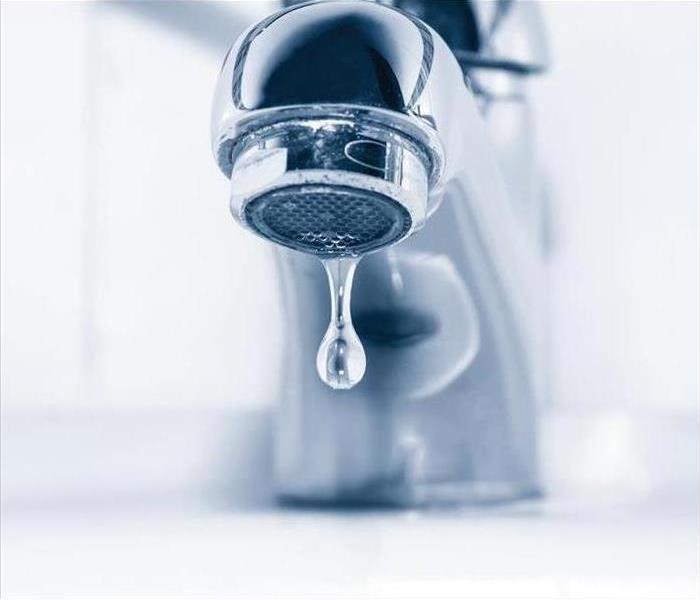 Allowing faucets to drip may prevent a broken pipe.
Allowing faucets to drip may prevent a broken pipe.
Three Simple Ways to Help Prevent Frozen or Bursting Pipes
For individuals in Ogden, UT who leave their homes for extended periods of time during cold weather, it may be important to know what to do to prevent water pipes from freezing and bursting. Water in a pipe that freezes and ultimately bursts may result in a family’s returning to a flooded home. This could create a terrible situation for a homeowner. While water damage repair professionals can certainly be called to complete a water pipe repair due to a broken pipe, there are steps that a homeowner can take to prevent the situation from occurring in the first place. Here are three simple ways to help prevent frozen or bursting pipes.
- Keep the Heat On and Keep the Air Circulating
In cold climates, it may be very helpful to keep the heater turned on anytime that the house will be vacant. Keeping the heat turned to at least 50 degrees Fahrenheit may help to prevent pipes from freezing. Additionally, opening cabinet doors underneath sinks and where pipes are located may help air to circulate around pipes and keep them warm. (The electric or gas heating bill may be a bit higher than simply turning the heat off. However, considering the mess that a flooded home can cause due to a burst pipe, the added heating cost may be worth it!)
- Turn Water in the Home Off or Allow Faucets to Drip
A homeowner may choose to turn the water to the home off entirely. However, if water is to remain on while the family is out of town, keeping faucets open a little bit may prevent a broken pipe. Water expands when it freezes. Therefore, faucets that drip can help prevent the freezing of stationary water and relieve pressure inside the pipes, avoiding the need for a water pipe repair due to a rupture.
- Wrap Pipes in Foam
Another simple way to avoid a water pipe repair is to wrap pipes in foam to keep the pipes warm. The warmer the pipes are, the better the chances are for everything to run smoothly while a homeowner is away!
When Frozen Pipes Threaten To Flood Your Home
6/24/2020 (Permalink)
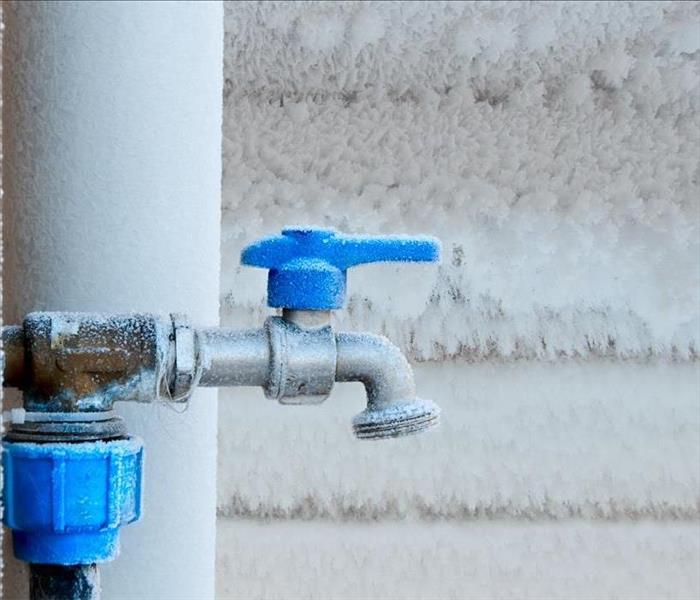 Frozen pipes are common during the winter.
Frozen pipes are common during the winter.
There are several causes of frozen pipes during the winter. Some of the most common reasons for this problem include:
- Extremely cold temperatures
- Faulty taping
- Inadequate insulation
- Broken or malfunctioning thermostats
When any of these seemingly small issues cause a pipe freeze, the frozen water expands and may rupture the pipe, creating a much larger problem. One of the best ways to avoid this type of water damage in Ogden, UT, is to check for cracks, splits, and other damage along the pipes before winter weather sets in.
How To Take Care of Frozen Water in the Pipes
If you do notice that you have frozen pipes, but they haven’t ruptured yet, you can take quick action to avoid further damages. Start by inspecting the pipes for cracks and other signs of damage. Next, use the main shut-off valve to prevent a flood if the pipes do rupture while you’re working. At this point, you can increase the amount of insulation around the pipes and wait for them to warm up, or you can use a gentle source of heat, keeping the temperature warm, not hot.
How To Identify Icy Water in the Pipes
How can you tell that the water in your pipes is frozen? One of the first and most obvious signs is that the water isn’t running from your faucet. However, depending on where the pipe freeze is located, some faucets may have running water while others don’t. If you suspect there’s frozen water, turn on the water in all faucets. This will help you identify where the problem is. Here’s an important tip: If you’re expecting a drastic drop in temperatures, you can leave the faucets open with a small trickle running through. This will help prevent the pipes from freezing and also helps melt any ice that has already formed.
When the Damage Has Already Happened
When frozen pipes have already caused damage in your home, cleanup and reconstruction professionals can help resolve wood that has become swollen and may be able to save water-soaked drywall.
Feel Confident About Your Cleanup and Mitigation Company
2/28/2020 (Permalink)
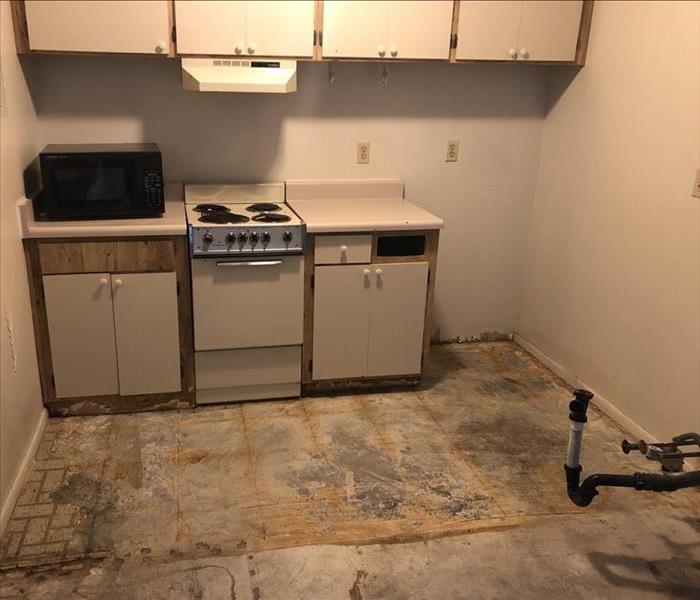 This kitchen suffered water damage in Ogden, UT.
This kitchen suffered water damage in Ogden, UT.
After your home has been damaged by water, fire, mold, or another disaster, some of the most important people you'll work with are those from a cleanup and mitigation company. Unfortunately, there are a lot of restoration professionals who claim to do great work but don't really have the equipment, expertise, or IICRC training to provide satisfactory results.
How can you recognize reputable technicians from less-than-savory companies?
Ask the Right Questions
One of the first steps you should take is to ask questions about each company and its technicians. The right questions can lead to informative answers:
- Does the restoration company have licensing, certifications, and insurance?
- Will the company give you a copy of their licenses, insurance, and bond paperwork
- How are estimates made? (Avoid any company providing estimates over the phone?)
- How long has the company been in your area?
- Are they local or nationwide?
- Will the restoration company work with your insurance provider?
It may be tempting to choose the first technician to offer you a fast, low estimate, but you'll find that this often leads to sloppy work and extra costs down the road.
Talk to Your Insurance Provider
Following any disaster, you should call your insurance provider as soon as possible. When you make this phone call, ask for recommendations regarding disaster cleanup and restoration companies. This insurance company is also interested in getting good results while keeping costs low. You're almost sure to get a recommendation for a restoration provider with the proper mitigation certificate and licensing.
Learn About Licensing and Credentials
Another vital step is understanding industry standards and credentials. The Institute of Inspection Cleaning and Restoration Certification, or IICRC, is a non-profit organization that sets the standards for inspection, cleaning, and restoration companies. The organization also provides certifications, so individual professionals and entire companies can become certified to show they are compliant with those standards.
The best results for your home restoration come from working with a Ogden, UT, company that has proper IICRC compliance, trained professionals, and the tools to do the job. Take time to research the company, get answers to vital questions, talk to your insurance provider, and understand credentials and compliance.
Hidden Dangers of Water Damage
12/27/2019 (Permalink)
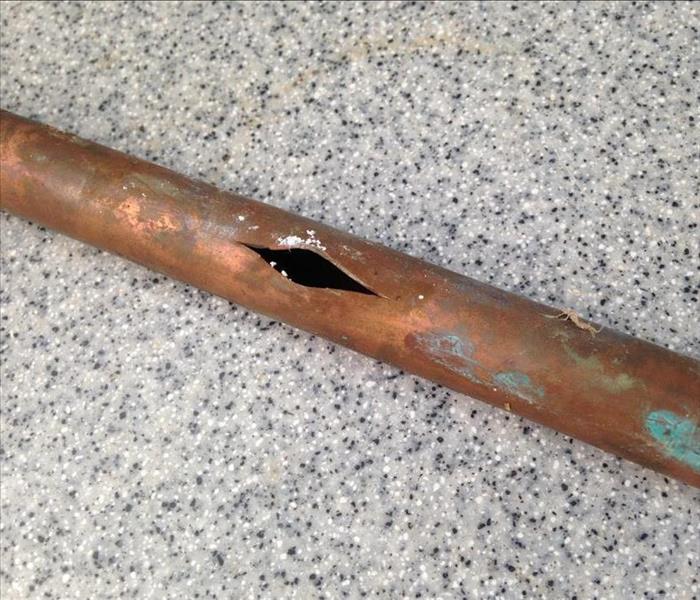 Pipe damage can cause severe water damage and leave hidden damages if not treated correctly.
Pipe damage can cause severe water damage and leave hidden damages if not treated correctly.
Flood water from a broken pipe can strike your home and leave standing water covering your floor. While many sources may describe how to clean the damaged area by yourself, the problem is often the unseen damage left behind by the water. Rather than tackle the situation by yourself, consider these hidden problems.
Categories of Water
Although the water flooding your home may look harmless, there is a real possibility the liquid is filled with harmful substances. Flood water has been classified into three categories to help water restoration and remediation professionals understand the danger levels of contaminates:
• Category 1: This water comes from a clean source such as a broken pipe and is considered safe.
• Category 2: This water contains a minor amount of contamination and is judged as unsafe.
• Category 3: This water is grossly contaminated and often comes from sources containing fecal matter, harmful chemicals, or pesticides.
Determining the danger level of the flood water in your home can be a difficult task. That is why most homeowners rely on a professional team to remove the contaminated water and sanitize the area.
Secondary Damage
Days and weeks after the water is gone, signs of secondary damage can suddenly appear. Mold colonies can emerge from still-damp areas of the home such as behind floorboards. The lower portion of walls can begin to sag, crack, and crumble. Tiles can start moving and the grout surrounding the ceramic area may disintegrate. Hardwood floors may also show signs of buckling and warping. Sadly, secondary damage can make an appearance long after your insurance company has settled your water damage claim.
Unseen Hazards
A quick response is often the answer to eliminating water damage problems. Whether it is a broken pipe or torrential rains that flood your home in Ogden, Utah, removing the water in a timely manner can minimize hidden damages and mitigate unseen hazards.
Hidden Dangers of Water Damage
10/24/2019 (Permalink)
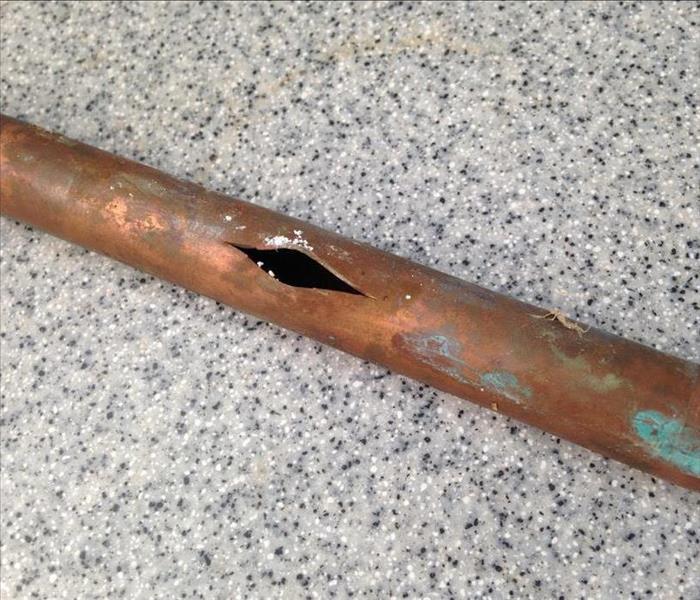 Broken pipe found in a home in Ogden, UT.
Broken pipe found in a home in Ogden, UT.
Flood water from a broken pipe can strike your home and leave standing water covering your floor. While many sources may describe how to clean the damaged area by yourself, the problem is often the unseen damage left behind by the water. Rather than tackle the situation by yourself, consider these hidden problems.
Categories of Water Damage
Although the water flooding your home may look harmless, there is a real possibility the liquid is filled with harmful substances. Flood water has been classified into three categories to help water restoration and remediation professionals understand the danger levels of contaminates:
• Category 1: This water comes from a clean source such as a broken pipe and is considered safe.
• Category 2: This water contains a minor amount of contamination and is judged as unsafe.
• Category 3: This water is grossly contaminated and often comes from sources containing fecal matter, harmful chemicals, or pesticides.
Determining the danger level of the flood water in your home can be a difficult task. That is why most homeowners rely on a professional team to remove the contaminated water and sanitize the area.
Secondary Damage
Days and weeks after the water is gone, signs of secondary damage can suddenly appear. Mold colonies can emerge from still-damp areas of the home such as behind floorboards. The lower portion of walls can begin to sag, crack, and crumble. Tiles can start moving and the grout surrounding the ceramic area may disintegrate. Hardwood floors may also show signs of buckling and warping. Sadly, secondary damage can make an appearance long after your insurance company has settled your water damage claim.
Unseen Hazards
A quick response is often the answer to eliminating water damage problems. Whether it is a broken pipe or torrential rains that flood your home in Ogden, UT, removing the water in a timely manner can minimize hidden damages and mitigate unseen hazards.
3 Steps To Help You Recover Quickly From Water Damage
9/29/2019 (Permalink)
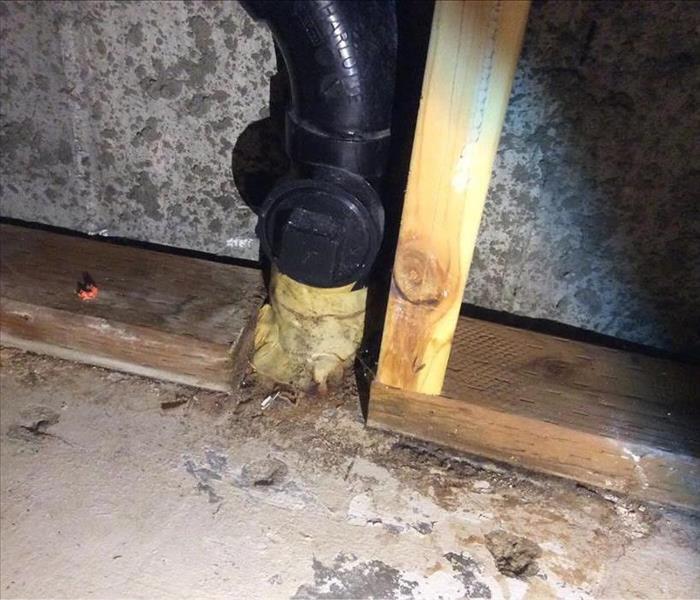 Residential water damage in Ogden, UT due to a crack in seal.
Residential water damage in Ogden, UT due to a crack in seal.
Plumbing problems can happen when you least expect them. If your home in Ogden, UT, has suffered from water damage due to broken pipes or other issues, you may be wondering how to approach the seemingly daunting task of water cleanup. Luckily, there are a few simple things you can do to help your home recover from water damage.
3 Steps to Recovery
1. Dry
It is important to make sure soaked or damp areas are dried out completely. When left alone, moisture can create the perfect conditions for mold growth. Besides being unpleasant to look at, mold growing in your home can be unsafe for several reasons:
• Odors
• Health Risks
• Staining
By thoroughly drying out wet areas, you can save yourself a lot of trouble by never giving mold a chance to invade your home.
2. Replace
If the water damage in your home involves black or gray water, then you may have to take some extra precautions. Black (or gray) water is water that has been contaminated by unsafe microorganisms or other elements. Most outside flood water or water from sewage leaks is considered black water. Items and materials that are porous or able to soak up water may have to be replaced after being contaminated by black water.
3. Disinfect
Items that can’t soak up water, such as objects made of materials like hard wood, plastic, or metal, probably don't need to be replaced. You can make sure these items are safe even if the flooding has involved black water by disinfecting and cleaning them before you put them back in use.
By working to keep mold away and cleaning up contaminated items, you can bring your home back to its original state after water damage has occurred. It can be helpful to contact a restoration service to assist you with some or all of the process, so you can return your life to normal as soon as possible.
Simple Facts About Carpets and Water Damage
8/7/2019 (Permalink)
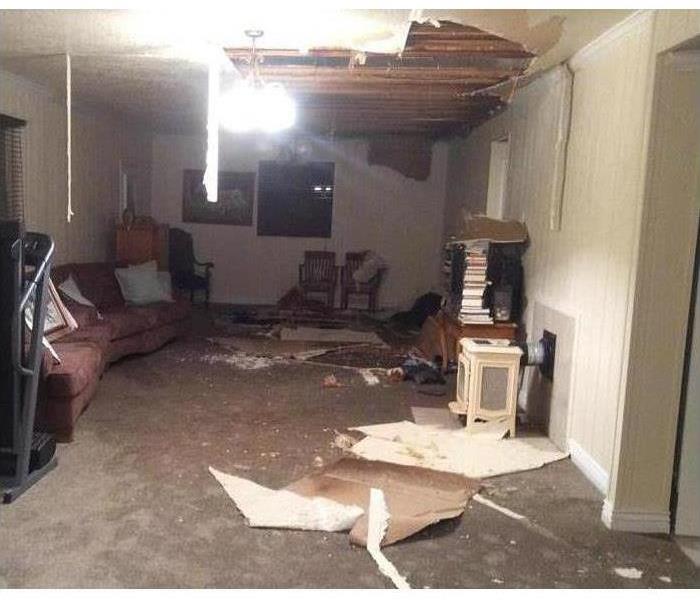 Water damage in Ogden, UT home.
Water damage in Ogden, UT home.
When a pipe break floods your home, the damage to property can be staggering. Although you may be confused about who to turn to and how to begin restoring your home, you can contact a trusted water removal company to help you handle the flood in your home in Ogden, UT. When the liquid is finally gone, homeowners often ask about their water damaged carpeting. Here are some simple facts to help you decide how to handle your soggy, smelly flooring.
7 Facts About Water Damaged Carpeting.
- Carpets are porous, so they love water.
That makes it easier to deal with them outside where they can be examined and stretched.
- Contaminated water makes for a contaminated floor.
Ask your professional water removal team about the flood water quality. If the liquid is classified grey or black, discard the carpeting and pad.
- Rugs and pads should be removed from the building within 24 hours of flooding.
Moving the wet items can prevent mold from developing inside your home.
- Carpeting often shrinks once it is dry again.
However, the good news is a professional carpet layer can often stretch it back out. The one exception may be carpeting containing wool.
- If the flood waters are clean from a pipe break, remove as much water as possible from the floor covering.
Next, remove the rug to a flat area and spread it out to completely dry. Use fans and dehumidifiers if possible.
- Laying damp carpeting can invite mold and mildew to grow.
It is best to wait to begin the replacement process until subfloor, pad, and flooring are completely dry.
- If you notice a yeasty odor once the carpets are back in place, call the professionals.
The smell can develop even weeks after your restoration is finished, and the odor usually means mildew or mold is growing inside your home.
Restoring your home can take time. Carpeting is only one small part of the damage that pipe break flood waters can do. If you understand the seven facts above, restoring or replacing your carpet is one portion of the flood problem you can be sure to conquer.
Ways To Minimize Water in Your Crawl Space
4/17/2019 (Permalink)
You may not think about water in your home’s crawl space being a big deal. If left unchecked, however, the humidity created by having a wet crawl space can lead to the formation of mold, which can cause serious damage to your home in Ogden, UT. The good news is that most flooding in your crawl space can be avoided with regular maintenance or remedied by water restoration specialists.
Here are some ways water can get into your home’s crawl space and what to do about it.
1. Indoor Plumbing Issues
If you have a busted pipe or a bathtub leak in your home, the water that escapes has to go somewhere. While it might seem like most of it ends up on your floor, it can also get trapped in walls, cabinets and the crawl space. It is crucial to have experienced professionals not only repair the leak but also inspect your home to assess the extent of the water damage. They can dry out a wet crawl space to prevent further complications.
2. Excessive Moisture by Foundation
Any time it rains, watch where the runoff flows. If it seems to flood near your home’s foundation because of the slope of your landscaping or the angle of your downspouts, it is likely to seep into your crawl space. In addition to correcting the flow of water away from your home in Ogden, UT, it is a good idea to have your crawl space inspected by a specialist.
3. Extraneous Groundwater
When you discover that you have a wet crawl space, even the ground on which your foundation rests could be the culprit. Water main breaks, a significant rise in the water table or an overloaded drainage system after a heavy storm can cause water to back up into the unfinished space beneath your ground floor. Water restoration technicians can pump out the excess water and dry the space.
Water in your crawl space can cause further damage if left unchecked. Regular maintenance and frequent assessments, particularly after a flood, can help prevent or resolve problems.
How Much Are Water Leaks Costing Your Small Business?
4/17/2019 (Permalink)
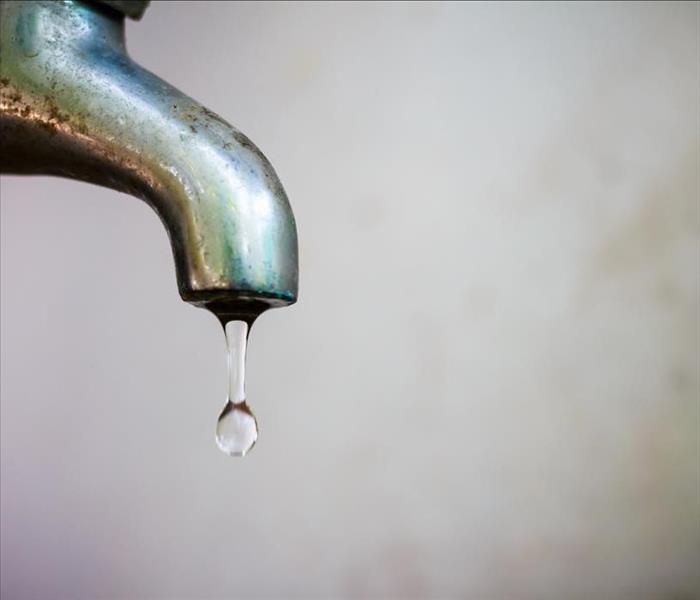 Dripping faucet in a Roy,UT commercial building
Dripping faucet in a Roy,UT commercial building
Common Leakages in Your Commercial Building
While a small water leak in your commercial building may not seem like a major problem, it’s something that should be addressed immediately. That’s because even minor leaks that are left unrepaired can cause extensive damage to your property and send your monthly water bill soaring. To protect the bottom line of your business in Roy,UT, make it a priority to monitor some of the most common leakage sources in your building.
1. Check All Faucets
At first glance, a dripping sink faucet may not look like it’s worth the effort of repairing, but over time those tiny trickles can add up to a lot of waste, as well as a larger bill from your water supply company. When you’re a commercial business owner, every penny counts. Taking a few hours to repair a faucet is a small investment that will result in a big payoff.
2. Keep an Eye on Your Toilets
A water leak around the outside seal of a toilet can quickly generate mold growth that could be costly to remove, and an internal toilet leak that causes water from your tank to improperly empty directly into the sewer will result in a large, unexpected spike in your water bill. By regularly checking both the outer seal and inner tank of your toilet, you can avoid both water damage and water waste.
3. Take Leaking Water Pipes Seriously
A pipe break, while rare, can cause major flooding that will wreak havoc on your commercial property. Since most pipes are located inside your building structure, a wet spot on your ceiling, floor, or wall is a critical warning sign that you have a serious breakage issue. A qualified water damage restoration specialist can help you identify what steps to take to begin the cleanup process.
Putting off repairs for any type of water leak inside your commercial property could mean you end up paying a big price later in the form of exorbitant water bills and a lengthy flood restoration process. Be proactive in monitoring and identifying all leakage sources, both small and large, around your building.
Did Harsh Winter Weather Damage Your Sprinkler System?
4/15/2018 (Permalink)
Spring is near, and with the arrival of warm weather comes lush, perfectly manicured green lawns in Ogden, UT. They are a pleasure to look at, but grass can also require a great deal of maintenance. One way lawns stay green is with the use of a sprinkler irrigation system. However, prior to turning on the water in spring and watching it spray across the grass, consider irrigation maintenance to check what damage the harsh winter weather did to the sprinkler pipes and controls.
Visual Clues
Before turning the sprinklers on, check the control panel for broken wires or damaged connections. Then turn each zone on individually to visually inspect the coverage area. Watch as each sprinkler scatters water to identify possible problems. Look for potential misaligned heads, water pressure glitches, or broken pipes. If there is a water problem, repairing the plumbing at the first sign of trouble can prevent foundation damage and sprinkler flooding. Here are three things to check for during irrigation maintenance:
• Water pressure issues can be a serious concern. Too much pressure can damage sprinkler heads, while insufficient water pressure may be from a broken pipe.
• Sprinkler heads can become misaligned or clogged. After cleaning clogged heads, reposition each to guarantee adequate spray.
• Gushing water or sunken areas of grass can mean a broken pipe. Consider calling in a plumbing expert to handle the situation quickly.
Broken Pipe
Since most sprinkler systems are usually set to water automatically, it is not uncommon to have flooding in basement or crawl space areas when sprinklers break. Should a flood occur, call in a flood restoration team that can quickly remove the water and return the area to working order.
Spring irrigation maintenance can help prevent pooling water, a flooded basement, and foundation damage. With routine upkeep, the sprinklers can stay in quality working condition all summer long. By conducting a yearly water management system examination, the resulting beautiful landscape can be the talk of the town.
For more information, please visit us athttp://www.SERVPROogdenut.com/.




 24/7 Emergency Service
24/7 Emergency Service




















